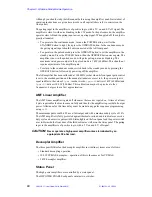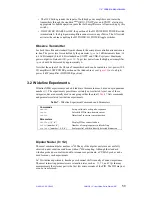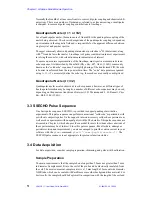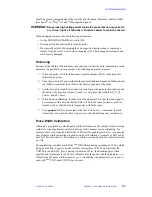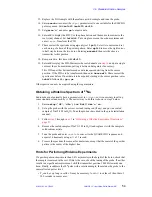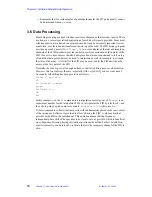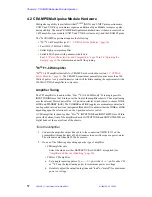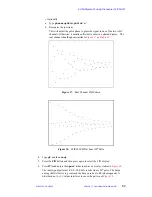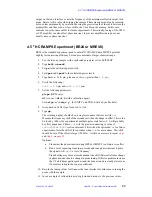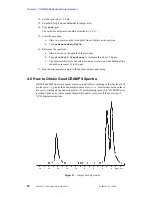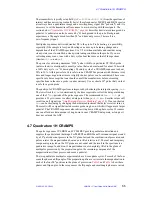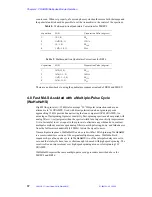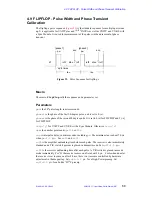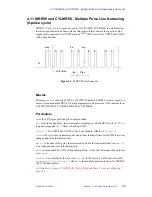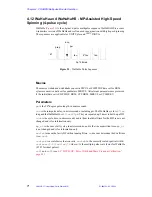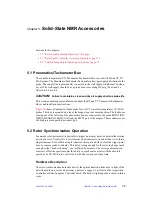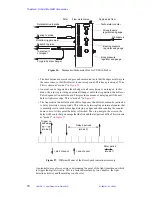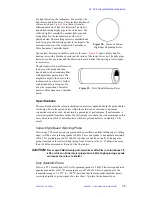
Chapter 4. CRAMPS/Multipulse Module Operation
59
VNMR 6.1C User Guide: Solid-State NMR
01-999162-00 C0402
the receiver and the fast ADC have a sufficiently short turn-on time for detection between
the pulses of BR24. Note that the value of
sw
in BR24 is set to 2 MHz to select the fast
ADC but the true dwell time is longer since the pulse sequence is responsible for turning
on and off the receiver and digitizer.
Note that the dwell time of the 500 kHz ADC of
UNITY
INOVA is sufficiently fast for BR24
but the turn-on time is not. Optionally, one can bypass the fast ADC with a custom cable
(not provided) that connects the unfiltered receiver outputs to the 500 kHz ADC. A special
BR24 pulse sequence can be written that compensates for the slower turn-on time of the
500 kHz ADC. This configuration can be set up by users, but it is not supported.
Solids Preamplifiers
For 300 MHz and 400 MHz systems an optional special high-power, 0-400 MHz
preamplifier module is available. This preamplifier has a passive T/R switch (in contrast to
the active T/R switch of the standard preamplifier module) and additional heat sinking on
the diodes to withstand a greater RF duty cycle. This preamplifier may also be used for low
band solids observe. This preamplifier can be used in-line during
1
H decoupling and is
labeled
High Power - 990888
. Set
rof2 = 0.2
µ
s
.
Newer systems and all systems 500 MHz and above use a
1
H/
19
F high-power preamplifier
module is supplied with an active T/R switch. The preamplifier module has a built-in l/4
cable and a high-pass filter (needed for CP/MAS) and can be used in-line during
decoupling. The appearance of this preamplifier is indistinguishable from standard
1
H/
19
F
module. Check the part numbers and instrument documentation if there is any doubt about
an existing preamp. Set
rof2=0.5
µ
s
.
Other preamplifiers are not suitable for CRAMPS and cannot be in line during CP/MAS
decoupling. Ring down of these preamps may be too long or the diodes may not withstand
the RF duty cycle.
MAS Probes for CRAMPS
Any CP/MAS probe with a
1
H-decoupler channel can be used for
1
H CRAMPS. The
quality of the result depends upon the minimum pulse width that can be obtained and the
inherent resolution of the sample. Highly crystalline materials have linewidths of less than
0.5 ppm. To achieve these line widths one should use a 1.5
µ
s 90
o
pulse or less. Amorphous
polymers may have minimum line widths of 3 ppm. A 90
o
pulse of 3.0 to 4.0 microseconds
may provide all the narrowing that is needed to obtain a result. Consult the probe
specification to determine the available 90
o
pulse.
Varian provides a 5 mm narrow-body single-tuned CRAMPS probe for 300 MHz and 400
MHz magnets, which can be tuned from
19
F to
1
H. This probe uses a body and a 5 mm rotor
similar to the Auto-MAS CP/MAS probes. The zirconia stator of the Auto-MAS probe
uniquely provides very low 1H background. For widebore magnets a 5 mm Chemagnetics
CRAMPS probe is available. In addition, any Auto-MAS CP/MAS probe or widebody
Chemagnetics CP/MAS probe with a rotor size of 5 mm or less can be used for CRAMPS.
Sync Module (UNITY, VXR-S only)
The Sync Module, located on the wideline receiver, provides a buffered 500 kHz signal
derived from the master oscillator. Its output is connected to the
EXT TIMEBASE
input on
the output board. A pulse sequence can delay until the next clock edge by using the pulse
sequence element
xgate(1.0)
. Clocking the beginning of the pulse sequence on 500
kHz output improves timing stability of the pulses for UNITY and VXR-S spectrometers.





